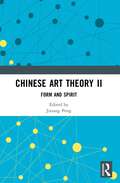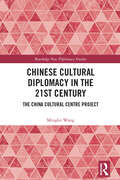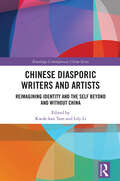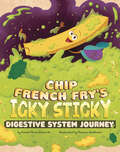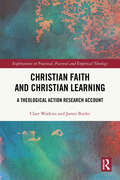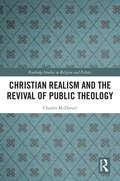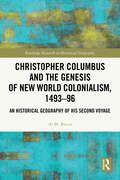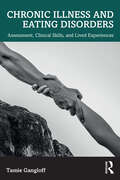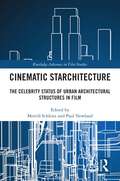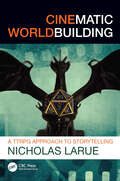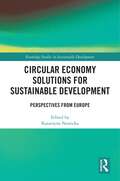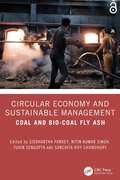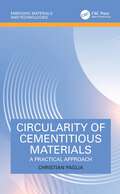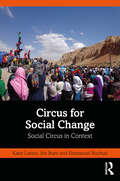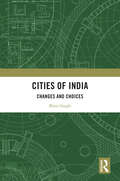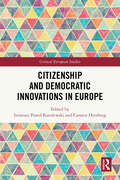- Table View
- List View
Chinese Art Theory II: Form and Spirit
by Peng JixiangAs the second volume of a two-volume set on Chinese art theory, this book introduces the typology of Chinese art and expands on the aesthetic and artistic theories of Chinese traditional art.The first part of this volume introduces representative genres of Chinese traditional art, including literary works, painting, and calligraphy. It covers scholar-artist art, folk art, palace art, and religious art at various levels and dimensions. The book demonstrates how Chinese traditional art uniquely embodies the nation's aesthetic sensibility, while reflecting its distinctive national traits in both creation and appreciation. The second part distills these theories to identify the fundamental principles and aesthetic characteristics that best represent the artistic spirit of Chinese tradition. Throughout, this book illustrates how traditional Chinese art reflects the cultural mindset and aesthetic consciousness of its people.This book is a valuable read for students and scholars of art studies, especially Chinese art theory and history. It will also appeal to anyone interested in the philosophical and aesthetic foundations of Chinese traditional art.
Chinese Business Negotiation: Art and Strategy (Routledge Advances in Management and Business Studies)
by Shougang Zhang Amily Wang GuenierChinese Business Negotiation offers readers a comprehensive insight into Chinese negotiation principles, shaped by centuries of cultural tradition and contemporary global business dynamics. Unlike competitive or zero-sum approaches, Chinese negotiation emphasizes harmony, trust, and long-term partnerships. This book introduces key concepts such as Shi (strategic advantage through interdependence), ethical wealth-seeking, and human-centered, empathy-driven communication.Structured across nine chapters, the book blends historical wisdom with modern business applications, providing practical frameworks for navigating cross-cultural negotiations. Readers will gain an understanding of strategic planning, flexible adaptation, and balanced communication in high-stakes deal-making. Case studies—including Lenovo’s acquisition of IBM’s PC division, SANY’s acquisition of Germany’s Putzmeister, Midea’s acquisition of KUKA Robotics, and Tesla’s negotiations in China—illustrate how these principles drive success in real-world scenarios.This book serves as a valuable resource for business professionals, scholars, and policymakers seeking to deepen their understanding of Chinese negotiation culture. By bridging Eastern and Western approaches, it equips readers with the tools to foster cooperative, mutually beneficial agreements in an increasingly interconnected world.
Chinese Computational Linguistics: 24th China National Conference, CCL 2025, Jinan, China, August 11–14, 2025, Proceedings (Lecture Notes in Computer Science #16052)
by Maosong Sun Zhiyuan Liu Ruifeng Xu Weiwei Sun Yubo Chen Zhiliang Tian Peiyong Duan Zhenghao LiuThis book constitutes the refereed proceedings of the 24th China National Conference on Chinese Computational Linguistics, held in Jinan, China, during August 11-14, 2025. The book refers a review of the key topics in Large Language Models, Machine Translation and Multilingual Information Processing, Text Generation, Dialogue and Summarization, Information Retrieval, Text Classification, QA, Language Resource and Evaluation, NLP Applications, ACL ARR Fast Track.
Chinese Cultural Diplomacy in the 21st Century: The China Cultural Centre Project (Routledge New Diplomacy Studies)
by Minglei WangThis book examines the China Cultural Centre (CCC) project’s establishment, operation, and programming through the lens of cultural diplomacy.The work illuminates the main structural and operational characteristics of the CCC project by highlighting their similarities and differences compared to other cultural diplomacy initiatives, especially the Confucius Institutes (CIs). It also provides insights on its working modes and associated activities, primarily based on the case of the CCC in Australia, supplemented by information from other CCCs. Furthermore, it sheds light on the implications for the CCC project, expanding current discussions about Chinese cultural diplomacy. The book holds that the operation and programming of CCCs reflect common views of Chinese cultural diplomacy—strategically orientated, state-led, and quantity-driven—while also highlighting the inclusion of foreign collaborators and a bottom-up strategy for facilitating engagement and understanding.This book will be of much interest to students of diplomacy studies, public diplomacy, foreign policy, Chinese politics, and international relations.
Chinese Development in Late-Socialist Laos: Negotiating Debt and Desire (Routledge Research on Asian Development)
by Phill WilcoxThis book uses the case of Chinese development in Laos to ask what development is and why it happens as it does.Development may seem self-evidently positive, but it is fraught with different agendas and seemingly competing visions of what so-called developing countries should become and how they should get there. As a country soon to graduate from Least Developed Country status as defined by the United Nations, Laos is a rich case study for considering the shifting drivers and priorities for development. This book considers how the rapid arrival of China has brought visions of development which converge and contest what has gone before, and how these inform individual and collective aspirations on the ground in Laos. This book starts by situating China’s Belt and Road Initiative and development priorities, before going on to consider what the rise of China in Laos really means for agendas of change and for individual aspirations. This book concludes that China is changing ideas of future making and visions of what a developed society looks like, but not yet altering a long-standing preoccupation with the very notion of development itself. Based on many years of original on the ground research in Laos, this book moves beyond macro scholarship on China’s influence to provide a nuanced picture of what Global China means and what development, aspiration, and future building mean in a changing Laos.It will be a thought-provoking read for researchers across the fields of global development and Asian studies.
Chinese Diasporic Writers and Artists: Reimagining Identity and the Self Beyond and Without China (Routledge Contemporary China Series)
by Kwok-Kan Tam Lily LiThis book presents new and original essays that capture the enigmatic and intriguing personal and imagined worlds of Chinese writers and artists in diaspora in the twentieth and twenty-first centuries.Including chapters on artist-writers such as Gao Xingjian, Dai Sijie, Ha Jin and Hong Ying, Tyrus Wong, and Shen Wei, the book explores personal cross-cultural experiences through their literary and other artistic works, reflecting on their cultural identity, their native home, and their new home, the past and the present. By writing, filming, and painting about their diaspora/diasporic experience, they are writing about their selves and the traumatic experience many of them have gone through in forgetting the past, forgiving the damage, and foreshadowing a future by re-visioning their selves. Their experience represents a generation’s quest for an identity of being Chinese but culturally distanced from China.As a study of cross-cultural human experience through the lens of literature, film, and other arts, this book will not only appeal to students and scholars of Chinese diaspora studies, it will also appeal to those with an interest in Chinese literature, film, and culture.
Chinese Education in a Changing Global Landscape: Projects, Policies and Practices from Schools to Universities (Routledge New and Critical Studies in Education)
by Catherine A. Simon Tingting YuanThis book offers a nuanced and research-based, critical account of the current status of Chinese education at differing levels within China, in the context of its position on the global economic and political stage.Following on from in-depth discussion of China’s global policies including the Forum on China and Africa Cooperation (FOCAC) action plan, and the Belt and Road Initiative (BRI), chapters present empirically based case studies showcasing a range of theoretical perspectives on higher education, neoliberalism and nationalism, teacher training and identity, and curriculum design, amongst other areas of research. The book contextualises the role of education internally within China as it faces global challenges and explores how China has developed its education programmes within its national and international strategies. Key trends in educational development are also addressed, such as the digitalisation of education and artificial intelligence.Ultimately offering a critical analysis of the Chinese education system in the context of globalisation, this book will be relevant to scholars, academics, and postgraduate students in the fields of international and comparative education, educational policy and politics, and Chinese education development more specifically. Educational policymakers may also find this volume of interest.
Chinese Grammar Q&A (Chinese Linguistics)
by Zhu DexiThis book offers a concise yet powerful analysis of critical Chinese grammatical concepts, adopting an authentic approach that considers the language on its own terms.Presented in a dialogic form, it discusses characteristics such as parts of speech, subjects and objects, as well as head-word and hierarchical analysis, and the Chinese grammatical system. By reviewing the contentious debates within Chinese linguistics since the 1950s—ranging from parts of speech classifications, subject-object relationships, to grammatical analysis methods—the author reveals how imposing Indo-European grammatical concepts onto Chinese language studies has obscured the language's inherent structural features. Through the use of rich examples, the book provides readers with an authentic view of the language to help them understand the unique structure of Chinese grammar.This essential read is ideal for linguists, scholars of linguistics, students of linguistics, and language learners interested in the Chinese language and grammar.
Chinese Scholars and Think Tanks' Constructions of China's National Interest: Hidden Hand on Demand (Rethinking Asia and International Relations)
by Sabine MokryThis book offers a systematic assessment of how International Relations scholars in mainland China and analysts at Chinese foreign policy think tanks influence the construction of China’s national interest. The detailed analysis shows how proximity to the state and the state’s signaled demand for expertise facilitate and constrain influence and puts forward a new approach for identifying influence by applying frame analysis to 150 foreign policy statements and combining it with quantitative content analysis of 4000 expert publications. Offering a new way of assessing and explaining Chinese foreign policy experts’ influence, understanding the environment in which they operate, and providing suggestions on how to analyze official foreign policy statements, this volume will be of interest to scholars of Chinese foreign policy and anyone working on expert influence in non-democratic regimes.
Chip French Fry's Icky, Sticky Digestive System Journey
by Jamee-Marie EdwardsFollow along as Chip French Fry goes from the mouth to the stomach to the intestines and beyond. Engaging and packed with facts, this book takes readers on a step-by-step illustrated adventure to uncover the icky, sticky journey through the digestive system.
Choctaw Code Talkers
by Blake A. HoenaIn this action-packed graphic novel, readers discover the incredible story of the Choctaw Code Talkers during World War I. When the U.S. Army needed a way to communicate military plans securely, they turned to a group of Choctaw soldiers to use their native language to create unbreakable codes. Follow these brave individuals as they fight on the front lines and outsmart the enemy using their little-known language as a secret weapon. Their efforts helped change the course of World War I and paved the way for future Indigenous code talkers. With dynamic illustrations and gripping text, this nonfiction graphic novel brings history to life for young readers.
Christian Faith and Christian Learning: A Theological Action Research Account (Explorations in Practical, Pastoral and Empirical Theology)
by Clare Watkins James ButlerFollowing a critical analysis of the pedagogical theology and practice of Christian learning, this book develops a radical alternative account of ‘faith learning’. Recognising the ways in which institutionally anxious churches are turning to processes of education and ‘discipling’, it takes the reader through a theological action research journey to offer a practical–theological response to the question of how Christian faith is learnt and handed on in ways that really make a difference. Through close engagement with the practicalities of one declining denomination (British Methodism), the authors offer a distinctive vision of Christian learning and enable fresh thinking and practice. There is a call for a move beyond educational ‘courses’ towards a more profound engagement with the complexities of real life as not only the place but the ‘matter’ of faith learning. Theologically, the book offers a vision which pursues questions of divine and human agency, the work of the Spirit in ‘learning’, the role of normative tradition, and the important place of Christian lay people and their daily lives in learning. Ultimately, it seeks to give substance to a fresh concept of ‘faith learning’, which is holistic, integrative, and inductively achieved, and finds its fulfilment in lives lived in faith, hope, and love.
Christian Realism and the Revival of Public Theology (Routledge Studies in Religion and Politics)
by Charles McDanielChristian Realism and the Revival of Public Theology analyzes Reinhold Niebuhr’s The Children of Light and the Children of Darkness 80 years after publication and argues that it provides pertinent lessons for the contemporary era. This book considers how Niebuhr’s book—as well as his other work—remains relevant and retains insights for an America which seems increasingly to be losing its moral bearings and political courage. The author examines the roots of political polarization in Niebuhr’s categories of the children of light and the children of darkness, finding it a more useful binary than liberalism vs. conservatism for understanding America’s culture wars and the growing sense that its political institutions are in terminal decay. This book seeks to show how public theology offers resources to foster democratic and moral renewal. It concludes by calling for a reinvigorated civil religion to promote unity rather than division. This book will appeal to scholars of American politics, Christian ethics, Christian Realism, public theology, and American religious history as well as historians of American Christianity.
Christianity and Horror Cinema (Routledge Studies in Religion and Film)
by Bryan P. StoneChristianity and Horror Cinema explores ways that Christian beliefs, spiritualities, practices, and symbols provide the religious and existential "depths" out of which the monsters of Western horror cinema have emerged, arguing that they are, in several respects, the monsters for which Christians are responsible. Horror cinema preys on Christianity’s narrative, moral, cultural, and aesthetic traditions; reverses them; upends them; inverts them; and offends them. But it also reflects and relies on them. The book focuses on seven subgenres in the cinema of horror: ghosts, witches, the demonic or Satanic, vampires, nature horror, zombies, and psychological horror. Each chapter traces the history of that subgenre, taking up a theological analysis of ways that horror cinema capitalizes on ambiguities, contradictions, anxieties, and tensions in Christianity—for example, its treatment of the body, nature, sexuality, women, or those it deems pagan or religiously "other." The author examines a variety of films that are important for thinking about the relationship of Christianity to horror cinema. The book will be of interest to scholars of religion, theology, and film studies.
Christopher Columbus and the Genesis of New World Colonialism, 1493–96: An Historical Geography of his Second Voyage (Routledge Research in Historical Geography)
by Al M. RoccaThis book explores the role of geography’s five themes: location, place, human-environmental interaction, movement, and region, in Christopher Colombus’s second voyage. It explores the impacting events that led to deteriorating relations between Columbus, the Spanish settlers (adventurers), and the indigenous Taíno and Carib people, creating a social paradigm of confusion, displacement, destruction, and the genesis of New World Colonization.
Chronic Illness and Eating Disorders: Assessment, Clinical Skills, and Lived Experiences
by Tamie GangloffChronic Illness and Eating Disorders addresses the intersection of eating disorders and the importance of treatment of clients with eating disorders and chronic illness, specific interventions, and resilience in a body that continues to change.This book explores the intricacies of those with chronic illness, and how it can lead to disordered eating. Chapters cover lifelong and acquired illnesses and conditions, visible and invisible disabilities, sports injuries, chronic pain, grief, and more. The author examines how each of these conditions can affect appetite, body image, and overall perception of food and health. Treatments such as EMDR and CBT are discussed alongside mindful approaches such as body neutrality.Therapists, dietitians, and other medical professionals will gain a deep understanding of body image disturbance and how that is different than body image distortion.
Cinematic Starchitecture: The Celebrity Status of Urban Architectural Structures in Film (Routledge Advances in Film Studies)
by Paul Newland Merrill SchleierCinematic Starchitecture explores how examples of famous architecture have circulated throughout cinema history across diverse genres. Building on the term "starchitecture" – coined in 1997 for dramatic, monumental structures designed to gain international attention and economic advantage – the authors demonstrate that a crucial part of an architectural structure’s iconic star status emerges through its engagement with (and codification by) the media, and with cinema in particular. This book explores how iconic architectural structures have performed a myriad of roles and functions that exceed buildings’ everyday uses or identities as aesthetic objects, location markers, or spatial settings, to show that countless films globally have featured famous buildings as inimitable components of narrative exposition, character development and/or identity construction. This volume will appeal to students, scholars, and researchers of film studies, media studies, and architecture and architectural history, as well as those in the areas of media and cultural studies, history, popular culture, and urban geography.
Cinematic Worldbuilding: A TTRPG Approach to Storytelling
by Nicholas LaRueEverybody has a story in them. Some people lack the language and the tools to tell that story effectively. As an avid tabletop role-playing game player, I’m amazed at people’s ability to tell stories on the spot. Both the players and the game masters are creating worlds in their minds and playing out the events, using improv, in real-time. Being an author and screenwriter, I know how difficult it is to create consistent and well-constructed characters, themes, and conflicts. I believe that storytellers looking to level up in the classroom, their hobby, or career could learn a lot from games like Dungeons & Dragons, Pathfinder, and others. This book seeks to give people the tools and language to create and master their worlds and characters, using TTRPG mechanics and rulesets as foundational elements. This book will contain insights and interviews from some of today’s most respected game masters, players, actual play actors, and we’ll also hear from some of the people behind the scenes responsible for creating these games, and how they view worldbuilding and storytelling for their audiences.
Circular Economy Solutions for Sustainable Development: Perspectives from Europe (Routledge Studies in Sustainable Development)
by Katarzyna NowickaThis edited collection offers fresh perspectives on sustainable development and social impact using a circular economy framework. Against the backdrop of escalating environmental challenges such as resource depletion and climate change, transitioning from a linear to a circular economy is a key step towards meeting the UN’s Sustainable Development Goals.Circular supply chains are pivotal in this transformation, focusing on resource efficiency, recycling, and waste reduction, with consumer roles also playing a key part. Building on theoretical foundations, the chapters in this book use quantitative and qualitative research to explore practical solutions and transformative potential across industries and urban settings, addressing global economic, environmental and social challenges. This book fosters a deeper understanding of circular economy principles and inspires actionable changes, with consumers becoming active participants in the circular economy. By focusing on consumer knowledge, eco‑innovation, and urban readiness, it provides a systemic, holistic approach to circular economy studies.This book will be of interest to researchers, academics, and students interested in enhancing their understanding of circular economy principles and practices, including those in environmental science, sustainable development, economics, and business.
Circular Economy and Sustainable Management: Coal and Bio-Coal Fly Ash
by Nitin Kumar Singh Siddhartha Pandey Tuhin Sengupta Sanchita Roy ChowdhuryThis book summarizes both conventional and emerging waste management approaches for fly ash, particularly with a focus on sustainability dimension – including its applicability, scope, methods, and challenges of bio-coal production. It covers the sustainability aspects of fly ash management and recent developments in methods, processes, and scope of bio-coal production as an alternative to conventional coal along with its implications for industrial ecosystems. It focuses on climate change, sustainability, and circular economy aspects of fly ash management approaches. Comprehensively covers all the dimensions related to coal and bio-coal fly ash and circular economy associated with it Discusses cradle-to-grave technology for bio-coal Emphasizes the efficient, economically viable, and environmentally sustainable use of coal and bio-coal fly ash Explores renewable fuel solutions and circular economy associated with it Encourages the use of bio-coal for boosting sustainability and circular economy This book is aimed at researchers and graduate students in environmental and civil engineering, as well as those working in clean technologies.
Circularity of Cementitious Materials: A Practical Approach (Emerging Materials and Technologies)
by Christian PagliaRecycling of materials in building and infrastructure applications are global concerns driven by natural resource preservation needs of modernized countries and sustainable development of emerging countries. This practical book explores the strategies necessary for successful recycling of cement-based materials to achieve sustainable and long service life. It investigates recycled cementitious materials to ensure decisive implementation and meet industry and societal challenges. Presents the state of the art in recycling one of the most used materials in today’s construction sector Covers construction and demolition waste and recycled concrete, UHPC, and road base material Aimed at readers in materials, civil, and construction engineering, this book offers guidance to professionals and researchers developing strategies for sustainable application of cement-based materials.
Circus for Social Change: Social Circus in Context (Routledge Advances in Theatre & Performance Studies)
by Katie Lavers Jon Burtt Emmanuel BochudIn this volume Social Circus is explored in depth by three Circus Studies scholars working with the aim of creating new ways of engaging with the field.Lavers, Burtt, and Bochud investigate the way that Social Circus transforms in response to its immediate environment, and particularly its social, political, and cultural context. Extensively illustrated, with photos of different Social Circuses around the world, and extensively annotated, Circus for Social Change: Social Circus in Context provides a portal into ways of seeing today’s Social Circus and is of interest to practitioners and scholars. Social Circuses explored in this volume include Cirqiniq in far North Canada; Galway Community Circus in the Republic of Ireland; Zip Zap Circus in Cape Town, South Africa; Circus Harmony in St. Louis, Missouri; Circus Laheto in Central Brazil; Women’s Circus in Melbourne, Australia; the Mobile Mini Children’s Circus (the MMCC) in various locations across Afghanistan; Cirque Hors Piste in Montreal, Canada; Sencirk in Dakar, Senegal; the Slow Circus Academy in Yokohama, JDS/Juggling de Shinshu, and the Moon Night Project in Nagano, Japan; Ponleu Selpak’s Performing Arts School and Phare Circus in Cambodia; Sirkus Magenta in Helsinki, Finland; and Le Plus Petit Cirque du Monde in Bagneux in the outskirts of Paris, France.This book will be of great interest to the general reader, to practitioners working within Social Circus or arts for social change, and to scholars, teachers, and students in schools, colleges, and universities.
Cities in the Metaverse: Spatial Computing, Digital Twins, Avatars, Economics and Digital Habitation on the New Frontier
by Duncan Wilson Andrew Hudson-Smith Valerio SignorelliCities in the Metaverse offers a comprehensive exploration of the intersection between urban environments and digital realms. The book examines:· The size and shape of cities in the Metaverse· Spatial computing and its impact on digital interaction· Digital twins in urban planning and management· Avatars and social dynamics in virtual spaces· Economic models emerging in the Metaverse· The influence of gaming on immersive digital landscapes· The impact of Artificial Intelligence on the Metaverse· Potential futures of digital habitationDrawing from architecture, computer science, urban planning, geography, social studies, and economics, the authors provide a multidisciplinary analysis of how virtual cities are shaping our digital future. Using key case studies, they trace the evolution from early cyberspace concepts to current spatial computing technologies, offering insights into both historical context and future possibilities. The book addresses key questions about the opportunities and challenges presented by metaverse technologies, including issues of accessibility, creativity, and the future of humans and artificial intelligence co-existing, side by side, in digital spaces. It serves as a practical guide, equipping readers with the knowledge they need to navigate the future of urban life in virtual environments with a thought-provoking examination of how we might build, inhabit, and govern cities in the Metaverse.The authors explore the concept of digital twins, demonstrating how these virtual replicas of physical spaces can revolutionise urban planning and management. They delve into the social aspects of the metaverse, examining how avatars shape our interactions and relationships in digital realms. Economic considerations are central to the book ethos, with an analysis of emerging models that often leverage blockchain technologies. The book addresses the challenges, potential pitfalls and ethical considerations in creating and inhabiting digital cities. At the same time, it takes a step back and examines already abandoned digital worlds, offering lessons from past attempts at creating virtual spaces. Essential reading for urban planners, geographers, economists, technologists, policymakers, and anyone interested in the future of cities and digital interaction, Cities in the Metaverse provides a balanced, informed perspective on this rapidly evolving field.
Cities of India: Changes and Choices
by Binti SinghUrban India stands at an interesting moment in history—at the cusp of massive changes and cautious choices. This book maps the new challenges and subsequent choices that emerge as India transitions into more urbanized situations, both spatially and culturally—to cleaner and renewable energy, integrating these new norms into the built environment, providing affordable and accessible physical and social infrastructure to all citizens, addressing the disproportionate climate risks of vulnerable communities, responding to the forces of globalization, conserving our heritage assets, deploying smart technologies for better city governance, designing for all, integrating hard and soft city dimensions for better policy outcomes and greater environmental and social impacts. It underlines and explores the nuances of urban design and urban planning, as well as how they are inextricably enmeshed with sustainability and climate action.The volume will be of great interest to scholars and researchers of urban studies, sociology, South Asian Studies, built environment, sustainability and climate studies, urban design and urban planning.
Citizenship and Democratic Innovations in Europe (Critical European Studies)
by Carsten Herzberg Ireneusz Paweł KarolewskiThis book brings together scholarship and debates on citizenship and democratic innovation, and examines how democratic innovations might change, or even consolidate, the existing contours of citizenship.Arguing that the nexus between research on citizenship and democratic innovations can be found in the praxis approach to citizenship, where citizenship can be framed as a realm of actions and practices, the book shifts the discussion from the institutional level into a more conceptual realm of analysis. Taking stock of the democratic innovations at the local level, the national level, and the EU-level, such as citizen assemblies, referendums, and participatory budgeting, the book further surveys and maps their contribution to the democratic quality of citizenship across various European countries.This book is of key interest to scholars and students of democratic innovations, citizenship studies, democratization, governance, and more generally public policy, and European Politics and Studies.
